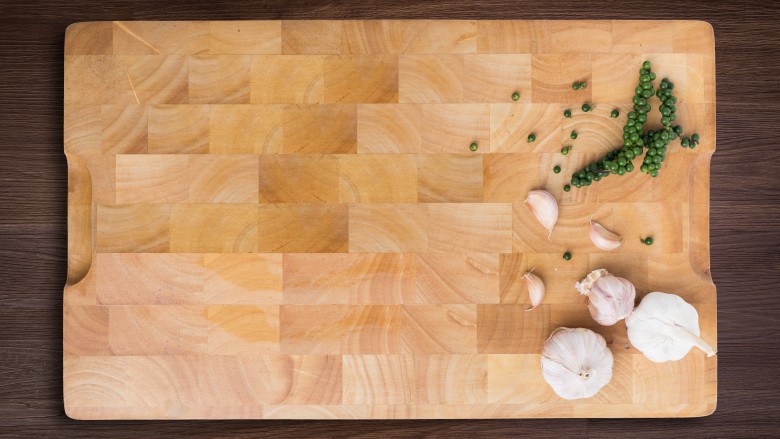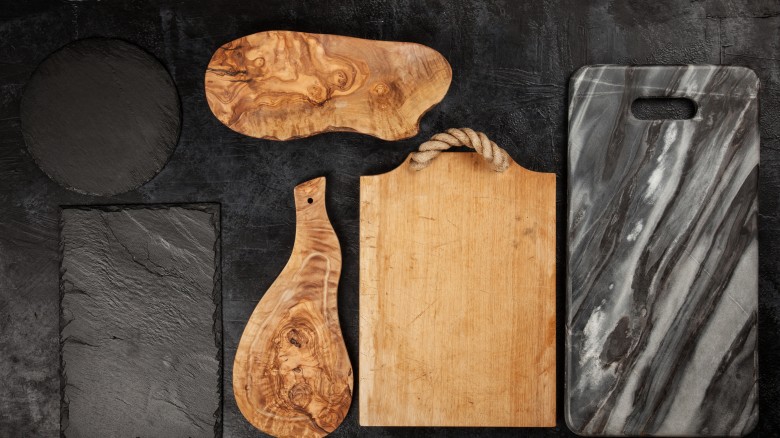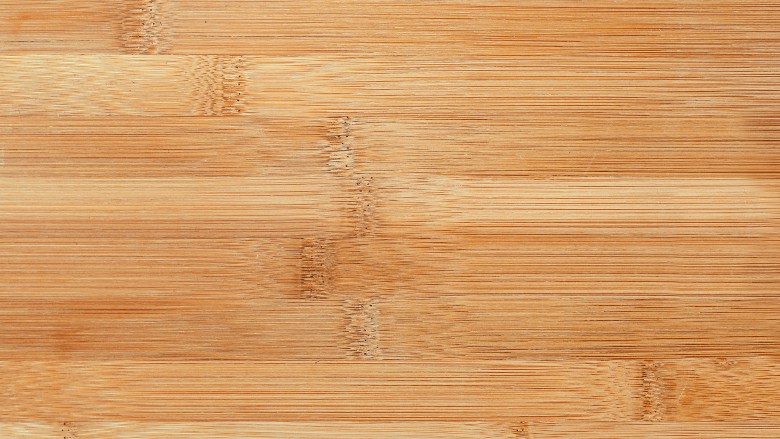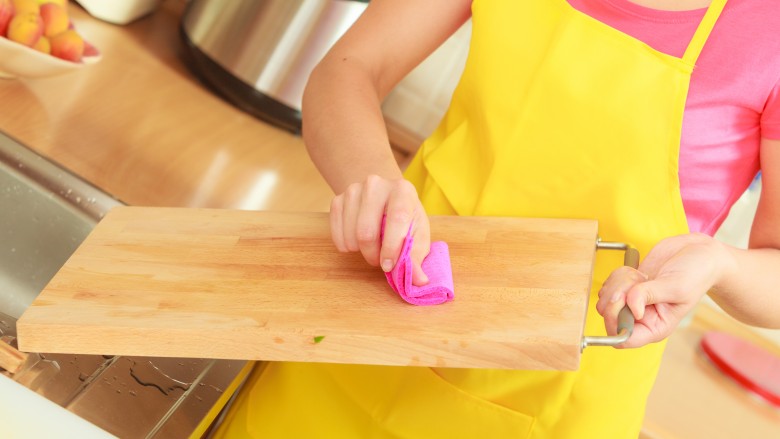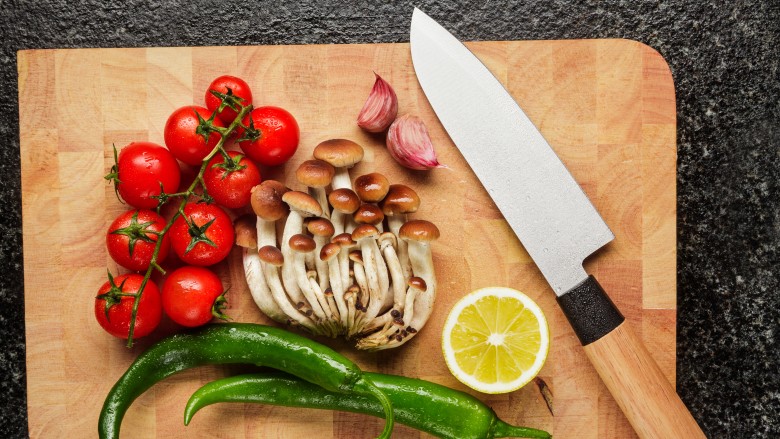Here's The Right Way To Use Your Cutting Board
A good set of knives and a reliable cutting board are the cornerstones of a well-equipped kitchen. We'll save the knives discussion for another day, but what's the best type of cutting board for everyday general use, and how do you take care of it once you've picked one? While there are no hard and fast rules about how to use a cutting board, you're better served if you understand a few of your board's basic needs and functions. Below, I've included some tips on how to choose your cutting board, how to care for it, how to maintain it, and how to best use it for a wide variety of culinary purposes.
Picking a cutting board material
After having owned, used, and abused plastic, bamboo, and wood, I can affirm that a sturdy wooden board is truly your best kitchen assistant. While some hang tight to the belief that plastic boards are easier to clean and are therefore somehow more sanitary than wooden ones, plastic surfaces actually harbor more bacteria. A better alternative would be bamboo, which is a renewable resource that can be harvested naturally. Even so, these boards are known to be harder than wooden surfaces, meaning they may cause more wear on your knives over time. On the other hand, a well-maintained, regularly oiled wooden board is easy to clean, ideal for cutting, and can last for many years. This is what you would find in most professional kitchens and happily, what you would find in my own home.
Wooden boards are kinder to your knives than plastic ones because the wood is sufficiently soft, doing less damage to your knives' edges. End-grain boards like the one above allow the edges to ride the vertical wood fibers and are incredibly durable. That said, plastic boards are reasonably sufficient and are far cheaper and easier to clean. Avoid glass, ceramic, and marble since these surfaces are too hard for your knives to deal with regularly.
As far as appearances go, nothing beats a sturdy, well-sourced wooden slab on your kitchen counter. It's classic and striking all at once. Professional cooks tend to choose wooden boards for their function as much as their beauty.
The right cutting board for your situation
When you're ready to choose a cutting board, it's important to consider the type of cook you are and what you plan to use the board for. You want to account for factors like size, cost, sanitation, function, and (lastly) aesthetics.
The size of your cutting board depends on how much space you realistically have in your kitchen, how much money you're willing to spend, and how you plan on cleaning the board. If you contend with limited counter and sink space, shop on a budget, or intend to use the dishwasher, you may opt for a smaller plastic board to suit these needs. Boards made of hardwoods, like maple, carry bigger price tags and should not be placed in the dishwasher or soak in water for long periods. A wooden board should be wiped down with soapy water immediately after use.
Seasoning a wooden cutting board
If you opt for a wooden cutting board, you'll need to season it before using it for the first time. Doing so helps prevent staining issues, slows absorption of smells and bacteria, and keeps water from getting into the cracks.
To season your board, give it an initial wash with mild soap. Simply use warm water and a natural dish soap. After wiping the board clean, apply a natural food-grade oil using a clean rag. Be sure to work the oil into the wood, applying pressure as needed. Lastly, set the board aside for a few hours to let the oil soak into the board. I like to give my own wooden board this kind of luxurious spa-grade treatment at least every couple of weeks — something I recommend if you use yours regularly.
What kinds of oils can be used for seasoning? While I'm a fan of John Boos block board cream and its natural blend of food-grade mineral oils and beeswax, there are plenty of options out there that'll do the job. Similar to John Boos, Howard butcher block conditioner is a natural option made with mineral oils and beeswax. For more detailed instructions on seasoning wooden boards, check out the step-by-step instructions from Teak Haus.
Additional tips to give your cutting board proper TLC
With all the careful deliberation about which board to buy and how to season it, you'll want to consider other issues related to replacement, food safety, and regular sanitization. Replace your cutting board when you notice that it has become worn or deeply cracked by knife contact. While this may be less of any issue with wooden boards, you'll find that plastic ones get deep cuts in them sooner.
If possible, try to have two cutting boards on hand — one for raw meats, poultry, and fish, and another for everything else. This helps avoid cross-contamination between foods. I like to use my nice wooden board for almost everything but reserve a less expensive plastic one for raw meat stuff since it's non-porous and can be cleaned in a dishwasher for maximum sanitization. In addition to regular washings, be sure to sanitize your cutting board periodically. I like to use white vinegar to sanitize my wooden cutting boards. If you encounter tough stains like I do after chopping beets, gently scrub the surface with baking soda. For strong smells related to onions, garlic, and the like, try rubbing the board with lemon juice and kosher salt. I swear by these natural cleaning methods! And here are other ways to sanitize your trusty cutting board.
Cutting board tricks to live by
After running a food business in a foreign country (shout-out to Colombia!), making pastries in two bustling New York City bakeries, and developing hundreds of dinner recipes for a food startup, I now have a couple of cutting board tricks up my sleeve. I'm ready and totally willing to talk.
Please, please, please place a damp, folded dish towel underneath your cutting board to prevent it from slipping under the pressure of your vigorous chopping. Slippage is extremely dangerous and can lead to unwanted accidents. This step is both easy and effective. When you feel more confident that the board won't slip and slide, you naturally exercise more ease and skill with your knife, leading to better prepped food and zero bloody fingers.
And use a big enough cutting board, for goodness' sake. While the tiny, animal-shaped cutting boards you get as birthday presents might be great for cutting individual fruits (...maybe), you're better off using larger boards for bigger jobs like prepping vegetables, trimming meats, and getting things done like a boss.
After reading this, I hope you feel fully prepped to choose your next great cutting board, care for the one you have, or get more out of the chopping experience. Keep it clean and safe.

